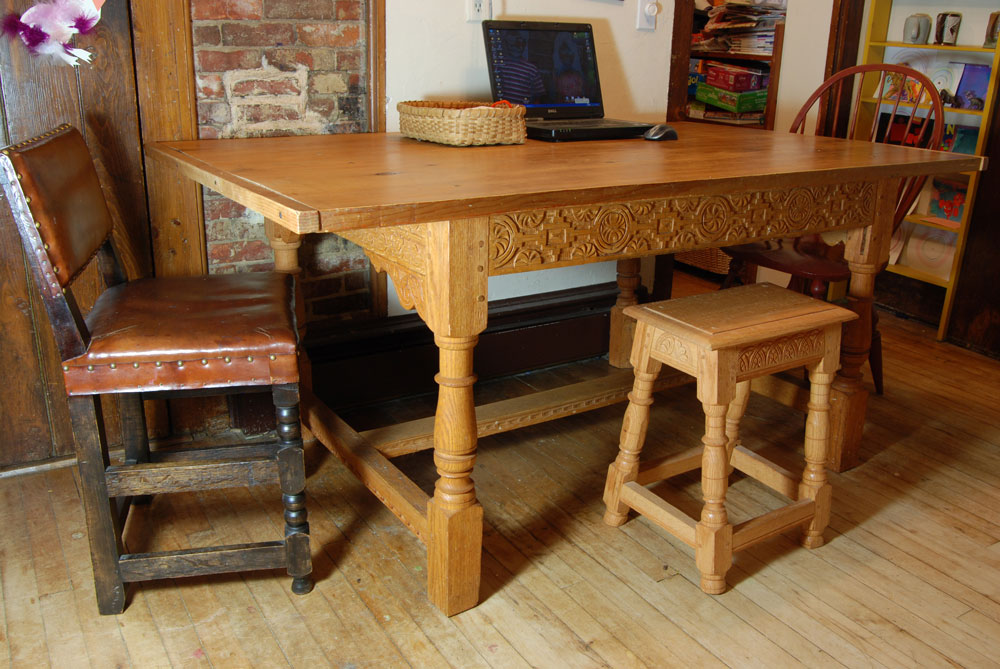What is all this about joint stools, you ask? English examples abound, but surviving New England ones are rare today. But in the period, they were so commonplace that it is hard to imagine a period house without them. Probate inventories filed at the time of a person’s death are a standard resource for material culture studies, and in these records we find numerous references to joint stools. Rarely itemized by themselves, they are usually lumped with a table or other seating furniture. In 1646, Michael Carthrick of Ipswich, Mass., had:
“one great cubberd £1; an old little table & 3 chaires 4s/6d; one bedsted in the
parlour £1/4s; one chaire & 3 joyned stooles 10s; 2 chestes & 3 boxes £1” [The values are pounds/shillings/pence. 12 pence to a shilling, 20 shillings to one pound (£). At that time in New England, a master tradesman might earn 2 to 2-1/2 shillings per day.]
A typical New England reference is this 1647 listing: “One longe table & frame, 4 joynt stooles & a bench £1-13.” In this case, the “table” is what we would call the tabletop, and the frame is just that, the understructure of the table. We find the same sort of thing back in old England, the stools once again lumped with the table and usually also a “form” – a joint stool stretched out to bench-length. In Essex, England, in 1638 John Osbourne’s inventory recorded “in the hall: One great joyned table, eight stooles and one forme, £1-10s.”
Poke around the English countryside enough and you can run into a table, joint stools and form that are all still in place, 350 to 400 years in one spot! The table is really just a joint stool made on a very large scale, same construction, same format. Easier, really. All 90° shoulders.
Randle Holme, the author of The “Academy of Armory & Blazon” had this to say about joint stools: “It is so called because all made and finished by the Joyner, haueing a wood couer: In most places in Cheshire it is termed a Buffit stool.”
Another interesting reference to them is a court case in London surrounding an infringement of trade issue, between the Turners of the City and the Joiners.
1633 We have called before us as well the Master & Warden of the Comp[an]y of Turners as also the M & W of the Compy of Joyners. It appeareth that the Compy of Turners be grieved that the Compy of Joyners assume unto themselves the art of turning to the wrong of the Turners. It appeareth to us that the arts of turning & joyning are two several & distinct trades and we conceive it very inconvenient that either of these trades should encroach upon the other and we find that the Turners have constantly for the most part turned bed posts & feet of joyned stools for the Joyners and of late some Joyners who never used to turn their own bedposts and stool feet have set on work in their houses some poor decayed Turners & of them have learned the feate & art of turning which they could not do before. And it appeareth unto us by custom that the turning of Bedposts Feet of tables joyned stools do properly belong to the trade of a Turner and not to the art of a Joyner and whatsoever is done with the foot as have treddle or wheele for turning of any wood we are of the opinion and do find that it properly belongs to the Turner’s and we find that the Turners ought not to use the gage or gages, grouffe plaine or plough plaine and mortising chisells or any of them for that the same do belong to the Joyners trade. [From Henry Laverock Phillips, Annals of the Worshipful Company of Joiners of the City of London, (London: privately printed, 1915) pp. 27, 28.]
Here in New England, there was no such restriction on a man’s trade. If you had the training and skills, you could work at both the bench and the lathe. The same was true in the countryside in England. In “Elizabethan Life: Home, Work & Land,” (1976) F. G. Emmison quotes a will from Essex England: “Thomas Quilter of Great Dunmow”, who combines the twin crafts of joiner and turner, divides his “working tools” equally between his two sons, giving each “a turning lathe and a grindstone unhanged.” The elder son is to have the larger grindstone if he will teach his brother “joining and turning in the best manner he can.””
For now, one last joint stool note, this from Roy Underhill who got it straight from Ben Franklin’s “The Autobiography of Benjamin Franklin.”
This obscure family of ours was early in the Reformation, and continued Protestants through the reign of Queen Mary, when they were sometimes in danger of trouble on account of their zeal against popery. They had got an English Bible, and to conceal and secure it, it was fastened open with tapes under and within the cover of a joint-stool. When my great-great-grandfather read it to his family, he turned up the joint-stool upon his knees, turning over the leaves then under the tapes. One of the children stood at the door to give notice if he saw the apparitor coming, who was an officer of the spiritual court. In that case the stool was turned down again upon its feet, when the Bible remained concealed under it as before. This anecdote I had from my uncle Benjamin.
— Peter Follansbee, one of the authors of “Make a Joint Stool from a Tree,” coming soon from Lost Art Press, Jennie Alexander and Follansbee. (Illustration at top: Eleanor Underhill; photos: Peter Follansbee.)




